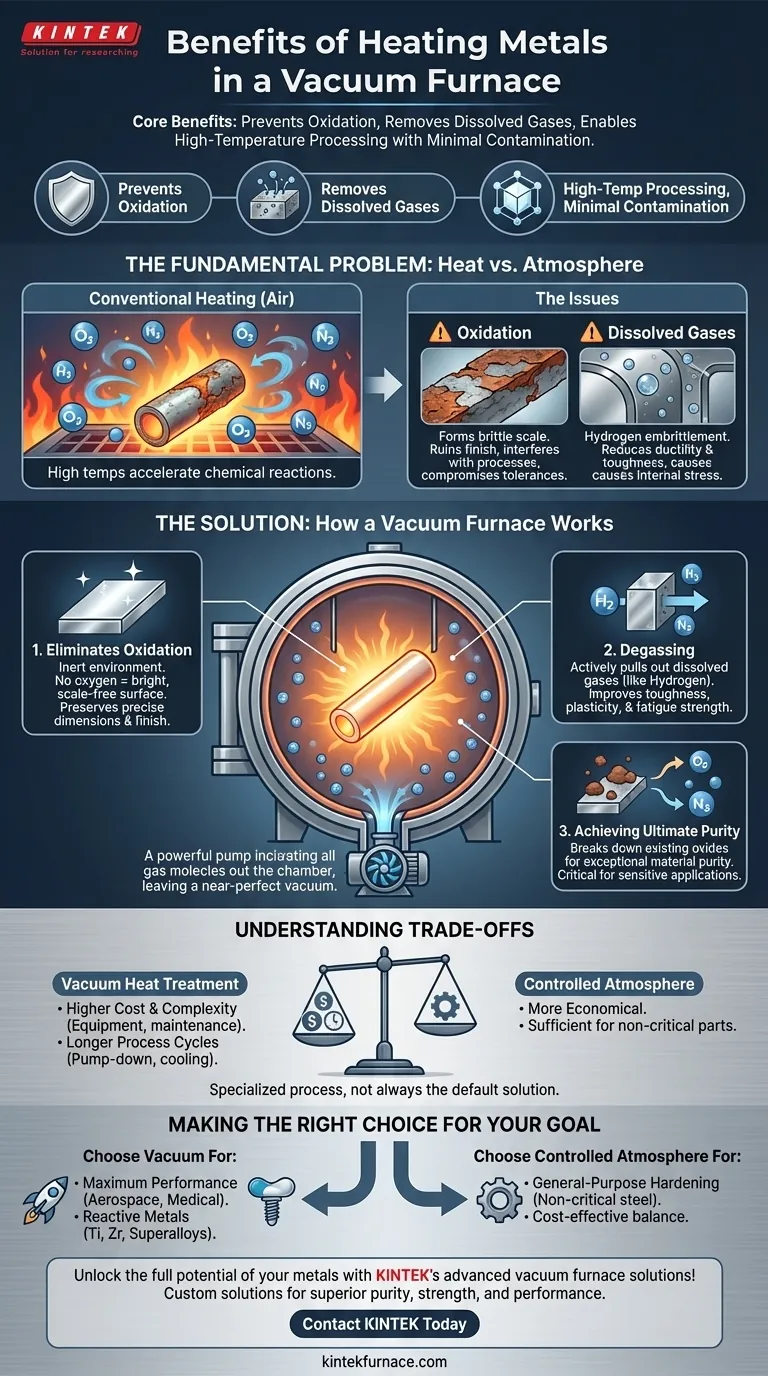At its core, heating metals in a vacuum furnace provides three primary benefits: it prevents oxidation, removes dissolved gases, and allows for processing at extremely high temperatures with minimal contamination. By creating an environment devoid of oxygen and other reactive elements, the process yields a final product with a pristine surface, superior purity, and enhanced mechanical properties.
The true value of a vacuum furnace isn't merely achieving a clean finish. It is a precision tool that empowers engineers to control a metal's environment at a microscopic level, preventing degradation and unlocking the full performance potential of advanced materials.
The Fundamental Problem: Heat vs. Atmosphere
Heat treatment is essential for altering a metal's physical properties, but it introduces a significant challenge: high temperatures drastically accelerate unwanted chemical reactions with the surrounding atmosphere.
The Inevitability of Oxidation
When heated in the presence of air, most metals rapidly react with oxygen. This reaction, known as oxidation, forms a brittle, flaky layer of oxide scale on the surface.
This scale not only mars the component's finish but can also interfere with subsequent processes like brazing, welding, or coating, and can compromise dimensional tolerances.
The Hidden Threat of Dissolved Gases
Atmospheric gases don't just react with the surface; they can dissolve into the metal itself. Hydrogen is particularly notorious for this.
Once inside the metal's structure, trapped hydrogen can lead to a phenomenon called hydrogen embrittlement. This severely reduces the metal's ductility and toughness, creating internal stress points that can lead to premature and catastrophic failure under load.
How a Vacuum Furnace Solves These Problems
A vacuum furnace addresses these atmospheric challenges by removing the problem itself: the atmosphere. By pumping the chamber down to a near-perfect vacuum, the environment becomes inert.
Eliminating Oxidation for a Pristine Surface
The most obvious benefit is the prevention of oxidation. By removing virtually all oxygen from the heating chamber, there is nothing for the hot metal to react with.
The result is a bright, clean, scale-free surface that requires little to no post-process cleaning, preserving the component's precise dimensions and finish.
Degassing for Enhanced Mechanical Strength
The vacuum environment actively pulls dissolved gases, like hydrogen and nitrogen, out of the metal. This degassing effect directly counteracts hydrogen embrittlement.
By removing these harmful elements, the process significantly improves the metal's core mechanical properties, including its toughness, plasticity, and fatigue strength.
Achieving Ultimate Purity
For highly sensitive applications, a vacuum can even break down existing, stable oxides on the metal's surface. As these oxides decompose at high temperatures, the freed oxygen is immediately pumped away by the vacuum system.
This purification process results in a final component with exceptional material purity, which is critical for the performance of specialty electronics and reactive metals.
Understanding the Trade-offs
While powerful, vacuum heat treatment is a specialized process with specific considerations. It is not the default solution for every application.
Cost and Complexity
Vacuum furnaces are significantly more expensive to purchase, operate, and maintain than their atmospheric counterparts. The systems require complex pumping mechanisms, seals, and instrumentation.
Longer Process Cycles
Achieving a deep vacuum takes time. The pump-down and post-process cooling cycles are often longer than in conventional furnaces, which can impact overall throughput.
When Is It Overkill?
For many common carbon steels and applications where a minor amount of surface oxidation is acceptable or will be machined off anyway, a simpler and more economical controlled atmosphere furnace is often sufficient.
Making the Right Choice for Your Goal
Selecting the correct heating environment depends entirely on your material and the performance requirements of the final part.
- If your primary focus is maximum performance and purity: Vacuum treatment is essential for critical components in aerospace, medical, and high-performance automotive applications.
- If you are working with reactive metals like titanium, zirconium, or nickel-based superalloys: A vacuum environment is non-negotiable to prevent immediate and severe oxidation.
- If your goal is general-purpose hardening of non-critical steel parts: A controlled atmosphere furnace often provides a more cost-effective balance of quality and efficiency.
Ultimately, vacuum heat treatment is the definitive industrial process for when you need absolute control over a metal's final integrity and properties.
Summary Table:
| Benefit | Key Impact |
|---|---|
| Prevents Oxidation | Yields clean, scale-free surfaces; preserves dimensions and finish |
| Removes Dissolved Gases | Reduces hydrogen embrittlement; improves toughness and fatigue strength |
| Enables High-Temperature Processing | Allows for minimal contamination and enhanced material purity |
Unlock the full potential of your metals with KINTEK's advanced vacuum furnace solutions! Leveraging exceptional R&D and in-house manufacturing, we provide diverse laboratories with high-temperature furnace systems, including Vacuum & Atmosphere Furnaces, Muffle, Tube, Rotary Furnaces, and CVD/PECVD Systems. Our strong deep customization capability ensures precise solutions for your unique experimental needs, delivering superior purity, strength, and performance for critical applications in aerospace, medical, and more. Contact us today to discuss how we can enhance your heat treatment processes!
Visual Guide

Related Products
- Vacuum Heat Treat Furnace with Ceramic Fiber Liner
- Molybdenum Vacuum Heat Treat Furnace
- 2200 ℃ Tungsten Vacuum Heat Treat and Sintering Furnace
- Vacuum Hot Press Furnace Machine Heated Vacuum Press Tube Furnace
- 2200 ℃ Graphite Vacuum Heat Treat Furnace
People Also Ask
- What is a vacuum furnace used for? Achieve Purity and Precision in High-Temp Processing
- Why use a vacuum furnace? Achieve Unparalleled Material Purity and Process Control
- Where are vacuum furnaces used? Critical Applications in Aerospace, Medical, and Electronics
- What is the process of vacuum heat treatment? Achieve Superior Metallurgical Properties
- What are the common applications of continuous vacuum furnaces in metal heat treatment? Boost Efficiency and Quality in High-Volume Production



















